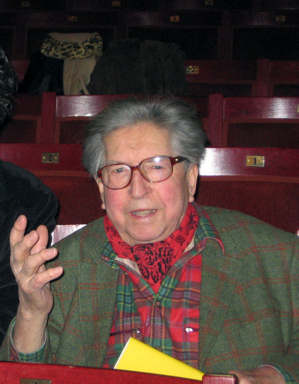Other Links
Editorial Board
- Editor - Bill Kenny
- London Editor-Melanie Eskenazi
- Founder - Len Mullenger
Google Site Search
SEEN
AND HEARD CONCERT REVIEW
Henri
Dutilleux, Stravinsky, Ravel, Debussy :
Phillippa Davies (flute), Marianne Thorsen (violin), Paul Watkins
(cello), The Nash Ensemble, Yan-Pascal Tortelier (conductor)
Wigmore Hall, London, 2. 4.2008 (AO)
It was a privilege to be in the Wigmore Hall on this very special
occasion. Henri Dutilleux had come from his home in Paris, to
receive the rarely awarded Gold Medal of the Royal Philharmonic
Society. It was introduced in 1870 to commemorate Beethoven’s
centenary, but only four French composers have been honoured –
Gounod, Messaien, Boulez and Dutilleux. Dutilleux, who was born
in 1916, is one of the great figures in 20th century
French music, yet what was special about this concert was that it
was conducted by the son of Paul Tortelier.

Henri Dutilleux
Dutilleux mentioned an occasion when he and Paul Tortelier scraped
together enough money to attend a performance of Stravinsky’s
Les Noces. So Stravinsky was honoured, too, in this recital
with his Concerto in D for String Orchestra. It was a good
choice, for this is fairly late Stravinsky (1946), contemporary
with Dutilleux’s emergence as a composer. It’s also appropriate
because Stravinsky is experimenting with wavering key colours,
loosening strict form, so that the music seems to shimmer. The
twelve member core of the Nash Ensemble was augmented by extra
musicians and despite the larger forces, Tortelier shaped the
elegant proportions so it danced.
Dutilleux’s Dyptique- Les Citations is an unusual
combination for harpsichord, oboe, percussion and double bass.
Britten had also used percussion and harpsichord together, and
there’s a quote from Peter Grimes as the piece was
initially written to honour Peter Pears. Nevertheless, Dyptique
is distinctively Dutilleux however, written with extreme but
precise economy. The double bass was added in 1991, darkening the
resonances. It quotes a passage from a piece for the organ
written by Jehan Alain, a composer friend of Dutilleux, killed in
battle in 1940. The oboe and double bass parts are so movingly
written that in some ways the balance falls in their favour –
especially when played by musicians of the calibre of Gareth Hulse
and Duncan McTier.
Extremely high violins introduced Ainsi la nuit, infusing
the static first section with gleaming brightness. Again, this is
distinctive Dutilleux, with elegant, delicate patterns evolving
and changing until the piece reaches its conclusion in another
static section where sound seems to float. Indeed, this section
is actually called “suspended time”. As to be expected the
standard string quartet is Nash ensemble territory par excellence,
so this performance seemed to choreograph itself, so much were the
musicians in accord. The long arches seemed like stretch, the
ostinato like en pointe.
The Royal Philharmonic Society may, remarkably, have omitted to
honour Ravel and Debussy, but this concert gave them tribute with
two small, but exquisite miniatures. Ravel’s Sonata for violin
and cello still sounds surprisingly modern. Perhaps it is the
sharp, angular patterns which echo Bartòk, perhaps the clean
melodic line, but as played here, by Marianne Thornton and Paul
Watkins, you can hear Ravel foreshadowing Dutilleux, simple forms
evoking depth beyond themselves. Debussy’s Syrinx, for solo
flute, distils in a few short minutes, concepts that seem to flow
out across time and space. The flute is an ancient instrument :
often played on its own because its very solitude evokes
contemplation. It doesn’t need adornment. Here, Philippa Davies
played with gracious modulation.
After the concert, Dutilleux said that this performance of
Mystère d’un Instant was the finest he had ever heard: quite a
comment since it was written in 1989. This version however
is a more recent revision, reducing the number of strings to 18
from 24. Certainly, there’s a feeling of space and light
about this piece. Tones seem to shimmer, wavering between
extremes of register, and textures seem to evaporate before
reforming. What’s also interesting is Dutilleux’s composing
rationale. Instead of using a formal strategy, in each of
the ten sections he seeks the “mystery of an instant”, captured
spontaneously as the musical idea emerges. Each section is an
individual “snapshot” as Dutilleux calls it, like a Hockney
collage perhaps, but animated and fluid. There’s a part where
four cellos interact, another where high, keening string lines
evolve into a tumble of quick, spiralling notes on cimbalom. A
wayward drum rhythm unfolds to a jerky, pizzicato sequence on
strings, itself superseded by a section where percussion and
cimbalom lead. Then the strings soared higher and higher and in
came the tam tam beaten at measured intervals, exactly as it would
be in an East Asian temple. Dutilleux's reference is explicit,
though what it signifies in the wider scheme of things I can’t
guess. But that’s why this music is interesting. It may be neat
and precise but it alludes to things beyond itself.
Anne Ozorio
Back
to Top
Cumulative Index Page
